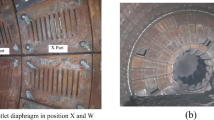Abstract
In this article, a method was investigated for elimination of the oxide layers and sand inclusion which have been created by turbulence in a kind of pressure plate part of the gray cast iron that is used in automotive industries. The pressure plate was produced by green sand Disamatic vertical molding line in a four cavities mold. In primary design of the gating system, the parts included some defects after production. After reviewing by optic microscopes and scanning electron microscope equipped to energy dispersive X-ray spectroscopy, it was realized that these defects are double oxide layers. The simulation results showed that the melt velocity was more than critical velocity just before entering into the cavity in the pressurized gating system (PGS). This agent was related to several factors such as size and thickness of the gate, choke position and type of connection ingate to the part at its model. This can lead to create double oxide layers. Reynolds number (Re) was used to show the turbulence or the non-turbulence of the fluid. Thus, a new version gating system (NVGS) was designed to decrease the melt velocity by changing the design of the pouring cup, vertical and horizontal runners, wells, chokes and ingates. The NVGS design was evaluated by the simulation software and compared with PGS design. The results showed that the melt in the ingate at the NVGS was smooth and non-turbulence. In addition, the Re was less than its critical value. Accordingly, parts produced by NVGS design were produced without any oxide layers and sand inclusion defect and final inspections were confirmed.













Similar content being viewed by others
References
C. Reilly, N.R. Green, M.R. Jolly, J.C. Gebelin, The modeling of oxide film entrainment in casting systems using computational modeling. Appl. Math. Model. 37, 8451–8466 (2013)
F. Najafzadeh, R. Raeiszadeh, Healing of double-oxide film defects in commercial purity aluminum melt. Metall. Mater. Trans. B 42, 331–340 (2011)
M. Masoumi, H. Hu, Effect of gating design on mold filling. AFS Trans. 02, 05–152 (2005)
J. Campbell, Castings, 2nd edn. (Elsevier, Oxford, 2003)
J. Campbell, R.A. Harding, The Filling of Castings, Basic Level (European Aluminum Association, Bruxelles, 1994)
F. Fernandes, A. Cavaleiro, A. Loureiro, Oxidation behavior of Ni-based coatings deposited by PTA on gray cast iron. Surf. Coat. Technol. 207, 196–203 (2012)
Y.C. Liu, J.M. Schissler, T.G. Mathia, The influence of surface oxidation on the wear resistance of cast iron. Tribol. Int. 28, 433–438 (1995)
R. Elliott, Cast Iron Technology (Elsevier, Manchester, 1988)
M. Jolly, J. Campbell, Ten rules form making reliable castings. Mod. Cast. 94, 36–39 (2005)
P. Cleary, J. Ha, V. Alguine, T. Nguyen, Flow modeling in casting processes. Appl. Math. Model. 26, 171–190 (2002)
C.M. Choudhari, B.E. Narkhede, S.K. Mahajan, Casting design and simulation of cover plate using AutoCAST-X software for defect minimization with experimental validation. Procedia Mater. Sci. 6, 786–797 (2014)
A. Modaresi, R.S.H. Mirzaei, Optimization of well designing in vertical casting gating systems by MAGMA software and its effect on casting defect reduction. Tech. Sess. Comput. Appl. II 11, 188–191 (2011)
C. Reilly, N.R. Green, M.R. Jolly, The present state of modeling entrainment defects in the shape casting process. Appl. Math. Model. 37, 611–628 (2013)
W. Abdul-Karem, N. Green, K.F. Al-Raheem, H.A. Hasan, Effect of vibration after filling on mechanical reliability in thin wall investment casting with fillability filling regime—part 1. Int. J. Adv. Manuf. Technol. 67, 2075–2082 (2013)
J.J. Runyoro, S.M.A. Boutarabi, J. Campbell, Critical gate velocity for film-forming casting alloys: a basic for process specification. AFS Trans. 104, 645–654 (1999)
A. Kermanpur, S.H. Mahmoudi, A. Hajipour, Numerical simulation of metal flow and solidification in the multi-cavity casting molds of automotive components. J. Mater. Process. Technol. 206, 62–68 (2008)
B. Vijaya Ramnath, C. Elanchezhian, V. Chandrasekhar, A. Arun Kumar, S.M. Asif et al., Analysis and optimization of gating system for commutator end bracket. Procedia Mater. Sci. 6, 1312–1328 (2014)
Author information
Authors and Affiliations
Corresponding author
Rights and permissions
About this article
Cite this article
Modaresi, A., Safikhani, A., Noohi, A.M.S. et al. Gating System Design and Simulation of Gray Iron Casting to Eliminate Oxide Layers Caused by Turbulence. Inter Metalcast 11, 328–339 (2017). https://doi.org/10.1007/s40962-016-0061-3
Published:
Issue Date:
DOI: https://doi.org/10.1007/s40962-016-0061-3




